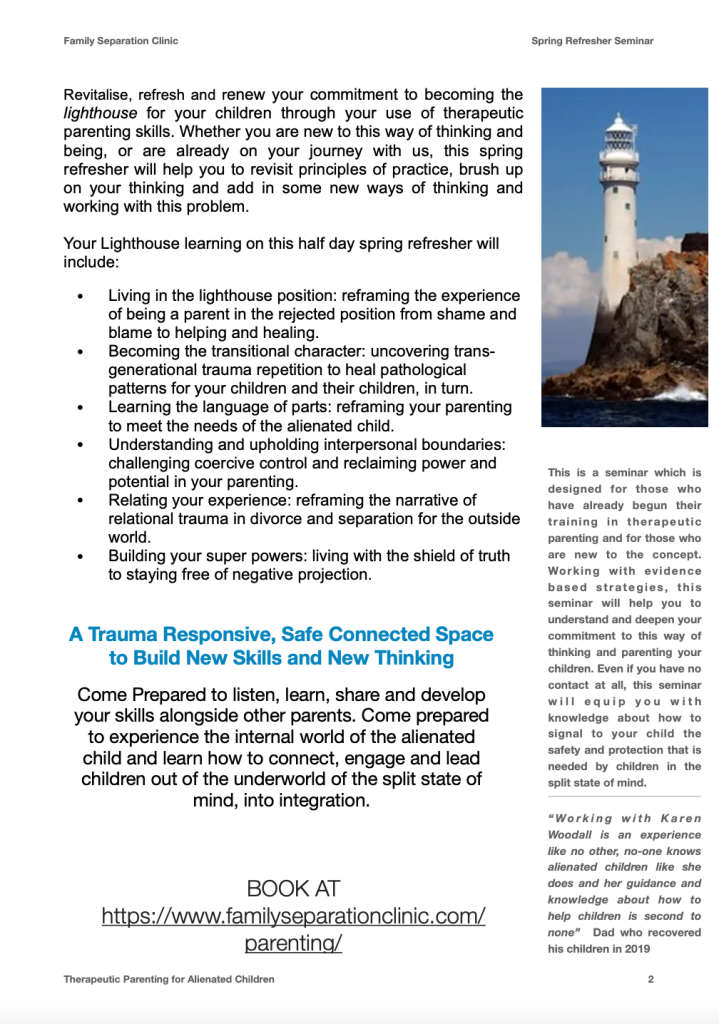As a Psychotherapist my long term interest has always been in how to help alienated children to recover from the harm which is caused when they are triangulated into parental relationships. Whilst most of this triangulation occurs during family separation, there are many families in which children are in the wrong place in the family hierarchy. Being best friends with your children is a good example of putting children in the wrong place at the wrong time, and yet it is a normalised relational behaviour in many families even when living together.
Over the past decade I have worked with over a hundred children who have suffered from emotional and psychological abuse in divorce and separation, in doing so I have been searching for the keys to understanding why some children align with one parent and reject the other. In comparing the way in which those children have behaved before, during and after the onset of the alignment and rejection behaviour, it has become clear to me that what these children have in common is disorganised attachment behaviours which are situational to being triangulated into the adult relationship.
Disorganised attachment occurs when the child’s caregivers become a source of fear. In a situation where a child is being triangulated into adult matters, perhaps by being exposed to information about a parent by the other, the child’s only sources of safety become anxiety provoking people who are to be feared. Whilst it is easy to understand why a child may become afraid of a parent they are told is harmful or dangerous, it is less easy to understand why the parent who is triangulating the child causes fear. This is because this relationship can look like a source of love and protection from the outside, whilst on the inside it is unpredictable and as a result, fear inducing.
Those who triangulate children into their feelings about the adult relationship are therefore involved in severing all sources of safety, first by overwhelming the child with their own experience and secondly by preventing the child from obtaining the safety and security they need in the relationship with the other parent. As a result, children in this situation enter into an unconscious defensive process in which they regulate the overwhelming caregiver by aligning with their views of the world (and other parent). What happens next is a form of projective identification in which the child enters into a process of ensuring that the parent in the rejected position is held firmly at bay. The purpose of this is to regulate the overwhelming caregiver and thereby create a sense of safety for the child. The child in this respect has become the architecht of a container of safety which is constructed out of projection, the parent in the rejected position has become the persecutor who must be kept at bay and the overwhelming, terrorising parent has become idealised and protected.
Why Therapeutic Parenting Works
Therapeutic parenting works with alienated children because it responds to the internalised problem in the child and the manner in which this is expressed in the family system. The problem that we have had with alienated children however, is that there is often a need for a structural shift in the family system before therapeutic parenting can be effective, which means that the power that the overwhelming parent has over the child must be ameliorated somehow. This is why going to court for younger children has always been necessary, unless the court can ameliorate the power over the child, therapeutic work is considered to be ineffective.
Therapeutic parenting doesn’t always require structural shifts to work however, this is because what therapeutic parenting does is skill the parent in the rejected position to understand and work with the projections in the system, avoiding and unravelling the child’s projective identification so that the trauma story can be properly addressed. Working with parents in the rejected position to enable them to see the internalised shifts the child has made which have created the fragile sense of safety that alienated children exist in, prepares the ground for the delivery of new messages and signals to the child that there is another, grounded and real place of safety that belongs to them, in relationship with the parent in the rejected position.
I have long been aware that the best therapist for a child who has become alienated is the parent in the rejected position and I have worked alongside many as they have recovered their children from the split sense of self and supported re-integration. Working with now recovered adult children, I have seen how this way of working supports longer term health and wellbeing through building of insight and resilience. Children who have been alienated are in need of specialist adapted parenting to bring them to a place of safety and where they have a parent in the rejected position who understands the world of projection they have been forced to live in, they can move back into the unconscious world of being a child to a healthy parent who is protective of their right to childhood (whatever their age). Working to help parents to understand and apply this knowledge is my first priority as a psychotherapist and will be at the forefront of all that I do for many years to come.





